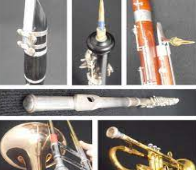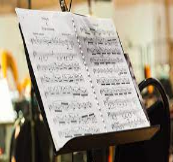Students may opt out of this year- long course at the end of the first semester. No previous experience is required.
The standards for Middle School Instrumental Music, Beginning Level enable students to begin receiving instruction on a wind, percussion, or string instrument of their choice with guidance from the music teacher. Instruction may begin at any middle school grade level. Students identify parts of the instrument and demonstrate proper instrument care, playing posture, instrument positions, fingerings, embouchure (if applicable), and tone production. Students apply emerging music skills to create and notate original work. Music literacy skills are emphasized as students read, notate, and perform music. Students use critical thinking skills to respond to, describe, interpret, and evaluate works of music as performers and listeners. Students identify opportunities to engage with music beyond the classroom. Opportunities are provided for students to participate in local, district, and regional music events as appropriate to level, ability, and interest. The beginning student is usually expected to furnish his or her own instrument. After-school rehearsal and performances may be required of students.
No Prerequisite Required
Story Board
Essential Question: How does our instrument become our musical voice?
|
Quarter |
Quarter 1 |
Quarter 2 |
Quarter 3 |
Quarter 4 |
|
Unit Title |
Do I choose the instrument or does the instrument choose me? |
Not only can I produce a sound but I can play seasonal music. |
Not only do we read the notes but we read AROUND the notes. |
Look at me! I’ve got this and am ready for more! |
|
Image Cue |

|

|

|
|
|
Focus of the Story |
The year begins with learning the parts of our instrument and how to care for it. We will practice handling their instrument safely and will demonstrate basic playing fundamentals. |
Our progress continues with preparing for our first performance. Students will perform various musical selections that showcase the first 5 pitches of their instrument while reading and performing in the language of music. |
In the third quarter we work on improving our range, note reading, writing, and scales while exploring new pitches. Students will work on developing their tone and note reading fluency while learning more challenging exercises and concert music. |
Our year ends with a solo music selection which requires increased and individual ownership on their instruments. Students will explore more challenging concert music, new scales, and will be able to perform while focusing on posture, counting, and tone quality. |
|
Transfer Goals |
Understand and find meaning in music as a form of community engagement through involvement as a performer, supporter, advocate, and audience member. Explore and connect personal interests, experiences, and aspirations through vocation, advocacy, and arts patronage. Use music literacy to demonstrate understanding of the elements of music and the ways they inform artistic performance and creative expression |
Understand and apply creative processes to guide the development of ideas, original works, and musical performance. Analyze, interpret, and evaluate musical works from a variety of cultures. Understand and find meaning in music as a form of community engagement through involvement as a performer, supporter, advocate, and audience member. Use music literacy to demonstrate understanding of the elements of music and the ways they inform artistic performance and creative expression. |
Understand and apply creative processes to guide the development of ideas, original works, and musical performance. Analyze, interpret, and evaluate musical works from a variety of cultures. Understand and find meaning in music as a form of community engagement through involvement as a performer, supporter, advocate, and audience member. Explore and connect personal interests, experiences, and aspirations through vocation, advocacy, and arts patronage. Use music literacy to demonstrate understanding of the elements of music and the ways they inform artistic performance and creative expression. Use technology as a strategic mechanism for improving music literacy and improving music performance. |
Understand and apply creative processes to guide the development of ideas, original works, and musical performance. Analyze, interpret, and evaluate musical works from a variety of cultures. Understand and find meaning in music as a form of community engagement through involvement as a performer, supporter, advocate, and audience member. Explore and connect personal interests, experiences, and aspirations through vocation, advocacy, and arts patronage. Curate a portfolio of accomplishments, experiences, and performance materials exhibiting oneself as an artist. Use music literacy to demonstrate understanding of the elements of music and the ways they inform artistic performance and creative expression. Use technology as a strategic mechanism for improving music literacy and improving music performance. |
|
Learning Targets |
I can read treble clef note names with ledger lines. I can read bass clef note names with ledger lines. I can read grand staff note names with ledger lines. I can read quarter, half, whole note/rest rhythms in 4/4 time signature. I can define pulse/tempo. I can identify keyboard note names. I can select a band instrument just right for me. I can identify the parts of my instrument. I can assemble and take proper care of my instrument. I can sit with proper musician posture. I can breathe properly while playing an instrument. I can use proper embouchure/grip while playing my instrument. I can describe the elements of how sound works.. I can sing the pitches in my music. I can perform basic technique on my instrument with proper posture/platform/frame. I can play concert Bb, C, D, Eb and F with correct fingerings. I can improvise in a call-and-response style I can play and understand music with steps and skips I can demonstrate proper practice habits at home. I can articulate properly on my instrument. I can play and understand rhythm patterns with whole, half, quarter and eighth notes/rests. I can sight read rhythm and note patterns with whole, half, and quarter notes |
I can read music in 3/4 time signature. I can play and define whole and half steps. I can play and define musical phrases. I can play a concert Bb tetrachord on my instrument. I can play concert Ab on my instrument. I can play and understand accent / staccato I can play in an ensemble with proper balance and blend. I can sing my music. I can understand how to tune my instrument. I can understand being an audience member and using my listening skills. I can understand how to critique a performance using a post-performance evaluation. I can describe music and instruments from other cultures. I can discuss my interests in music using music terms. I can understand how key signatures work. I can play and understand D.C. al fine. I can play music in 2/4 time signature. I can understand how instruments are pitched in different keys. I can compose a 4-measure variation of a melody. I can play a scale pattern on my instrument. I can play concert E, A, and Bb on my instrument. I can play concert F major tetrachord on my instrument. I can play concert Bb major scale on my instrument. I can play dotted quarter rhythms on my instrument. I can identify how technology influences music. I can connect music and art to other interests. |
I can identify whole and half steps. I can identify enharmonic spellings in my music. I can play half-step patterns on my instrument. I can play a concert Eb, C major tetrachord on my instrument. I can play concert Eb, F major scale on my instrument. I can sing the lines in my music. I can improvise on my instrument using call-and-response. I can tune my instrument properly using a tuner. I can play dotted eighth note patterns on my instrument. I can sightread level 1 music. I can discuss some elements of Baroque and Classical music history. |
I can compose a theme and variations piece. I can compose a 4-measure variation. I can perform my Solo and Ensemble piece. I can play concert C, Ab major tetrachord on my instrument. I can play concert Ab major scale on my instrument. I can rehearse and perform my concert music properly. I can reflect on my concert music performance. I can play my instrument with proper intonation. I can sing my lines of music. I can tune my instrument using a tuner. I can sightread level 1 music. I can evaluate my own and others’ music performances. I can discuss careers in music. I understand the functions of music. I can discuss Romantic and Twentieth music history. I can compose music using technology. I can be creative in music. I understand the ethical standards of copyrighted m |

